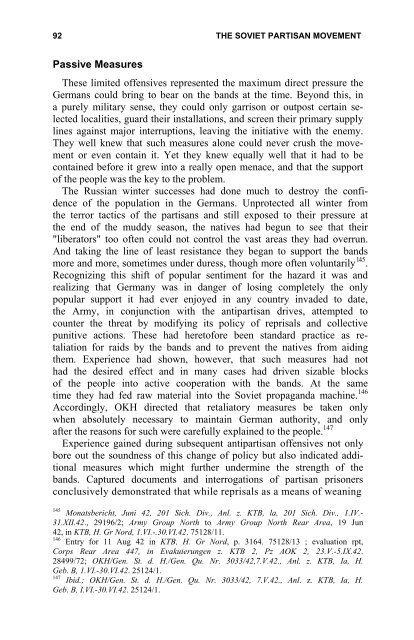the soviet partisan movement 1941-1944 by edgar m. howell
the soviet partisan movement 1941-1944 by edgar m. howell
the soviet partisan movement 1941-1944 by edgar m. howell
Create successful ePaper yourself
Turn your PDF publications into a flip-book with our unique Google optimized e-Paper software.
92 THE SOVIET PARTISAN MOVEMENT<br />
Passive Measures<br />
These limited offensives represented <strong>the</strong> maximum direct pressure <strong>the</strong><br />
Germans could bring to bear on <strong>the</strong> bands at <strong>the</strong> time. Beyond this, in<br />
a purely military sense, <strong>the</strong>y could only garrison or outpost certain selected<br />
localities, guard <strong>the</strong>ir installations, and screen <strong>the</strong>ir primary supply<br />
lines against major interruptions, leaving <strong>the</strong> initiative with <strong>the</strong> enemy.<br />
They well knew that such measures alone could never crush <strong>the</strong> <strong>movement</strong><br />
or even contain it. Yet <strong>the</strong>y knew equally well that it had to be<br />
contained before it grew into a really open menace, and that <strong>the</strong> support<br />
of <strong>the</strong> people was <strong>the</strong> key to <strong>the</strong> problem.<br />
The Russian winter successes had done much to destroy <strong>the</strong> confidence<br />
of <strong>the</strong> population in <strong>the</strong> Germans. Unprotected all winter from<br />
<strong>the</strong> terror tactics of <strong>the</strong> <strong>partisan</strong>s and still exposed to <strong>the</strong>ir pressure at<br />
<strong>the</strong> end of <strong>the</strong> muddy season, <strong>the</strong> natives had begun to see that <strong>the</strong>ir<br />
"liberators" too often could not control <strong>the</strong> vast areas <strong>the</strong>y had overrun.<br />
And taking <strong>the</strong> line of least resistance <strong>the</strong>y began to support <strong>the</strong> bands<br />
more and more, sometimes under duress, though more often voluntarily l45 .<br />
Recognizing this shift of popular sentiment for <strong>the</strong> hazard it was and<br />
realizing that Germany was in danger of losing completely <strong>the</strong> only<br />
popular support it had ever enjoyed in any country invaded to date,<br />
<strong>the</strong> Army, in conjunction with <strong>the</strong> anti<strong>partisan</strong> drives, attempted to<br />
counter <strong>the</strong> threat <strong>by</strong> modifying its policy of reprisals and collective<br />
punitive actions. These had heretofore been standard practice as retaliation<br />
for raids <strong>by</strong> <strong>the</strong> bands and to prevent <strong>the</strong> natives from aiding<br />
<strong>the</strong>m. Experience had shown, however, that such measures had not<br />
had <strong>the</strong> desired effect and in many cases had driven sizable blocks<br />
of <strong>the</strong> people into active cooperation with <strong>the</strong> bands. At <strong>the</strong> same<br />
time <strong>the</strong>y had fed raw material into <strong>the</strong> Soviet propaganda machine. 146<br />
Accordingly, OKH directed that retaliatory measures be taken only<br />
when absolutely necessary to maintain German authority, and only<br />
after <strong>the</strong> reasons for such were carefully explained to <strong>the</strong> people. 147<br />
Experience gained during subsequent anti<strong>partisan</strong> offensives not only<br />
bore out <strong>the</strong> soundness of this change of policy but also indicated additional<br />
measures which might fur<strong>the</strong>r undermine <strong>the</strong> strength of <strong>the</strong><br />
bands. Captured documents and interrogations of <strong>partisan</strong> prisoners<br />
conclusively demonstrated that while reprisals as a means of weaning<br />
145 Monatsbericht, Juni 42, 201 Sich. Div., Anl. z. KTB, la, 201 Sich. Div., 1.IV.-<br />
31.XII.42., 29196/2; Army Group North to Army Group North Rear Area, 19 Jun<br />
42, in KTB, H. Gr Nord, 1.VI.-.30.VI.42. 75128/11.<br />
146 Entry for 11 Aug 42 in KTB, H. Gr Nord, p. 3164. 75128/13 ; evaluation rpt,<br />
Corps Rear Area 447, in Evakuierungen z. KTB 2, Pz AOK 2, 23.V.-5.IX.42.<br />
28499/72; OKH/Gen. St. d. H./Gen. Qu. Nr. 3033/42,7.V.42., Anl. z. KTB, Ia, H. <br />
Geb. B, 1.VI.-30.VI.42. 25124/1.<br />
147<br />
Ibid.; OKH/Gen. St. d. H./Gen. Qu. Nr. 3033/42, 7.V.42., Anl. z. KTB, Ia, H.<br />
Geb. B, I.VI.-30.VI.42. 25124/1.
















